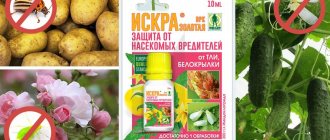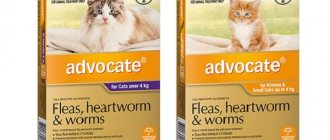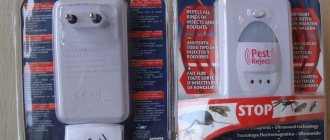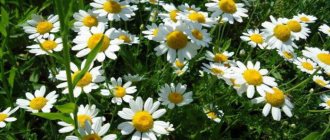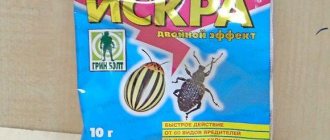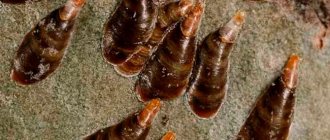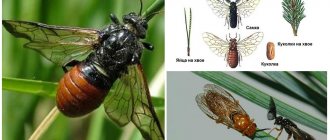Signs
The appearance of pests on an apple tree can rarely go unnoticed. They begin to “live” on all parts of the tree. However, they most like young shoots, flowers and buds. Depending on the type of pest, the signs may differ slightly, but the main ones are bogging, twisting, and growth arrest.
Apple flower beetle
This pest is nothing more than a small beetle, a member of the weevil family. Its shade is indistinct, yellow-brown. As its name suggests, it feeds on flowers. The flower beetle lays its eggs in the buds; while still a larva, it eats everything from the inside, leaving its secretions that prevent the flower from opening. If it is not detected in time, the damage can be very significant.
Flower beetle on an apple tree.
California scale insect
A very harmful and common insect that can significantly spoil the harvest. The scale insect devours not only the apple tree, it loves other fruit trees and shrubs. During a season, it can breed two generations, and under good climatic conditions even three. The larvae overwinter in any irregularities on the tree bark.
Californian scale insect on an apple tree.
They look like insects with a small, dense shell. It is from this that the name comes, and it is this shield that helps the pest protect itself from the effects of chemicals and the birds that hunt them. Their color is brownish-brown, and when the insect dies, a ruby trail remains on the apple tree.
Aphid
One of the smallest, but most dangerous pests. It multiplies very quickly and takes over territory. More than 20 generations can grow in a season, most of the population are females.
Aphids on an apple tree.
These pests are amazingly omnivorous; they can breed anywhere, under any climatic conditions and despite any weather. Only when the season ends do aphids lay eggs to wait out the cold. Most of all she loves warm, humid summers.
Fruit mites
There are several varieties of these pests, but they all cause harm to apple trees. They love the juice of young leaves, so they often fall off in mid-summer. They settle on the shoots and glue the leaves together with their web.
Fruit mites on an apple tree.
Ticks can wait out cold weather in the bark of an apple tree; they pass through two or three generations during the season. Due to their exposure, trees' immunity decreases, they get sick and suffer from the cold in winter.
Brown fruit mite
I would especially like to mention this representative of ticks. They accumulate so abundantly on the branches that they create the impression of a continuous coating. They are noticeable by their brown-gray cover, although the size of the pest itself is small.
Brown fruit mite on an apple tree.
leaf roller
Leafrollers are very fond of young buds, leaves and even ovaries. Caterpillars fly around all the green parts of the tree with their webs. They overwinter in cracks in the bark, falling into torpor.
Leaf roller on an apple tree.
If they are not controlled, the damage to trees is very noticeable. In the caterpillar stage they are especially voracious. There are several types of this pest:
- Omnivore;
- Kidney;
- Hawthorn;
- Willow;
- Currant.
But all of them are equally harmful to the apple orchard.
codling moth
Insects that feed on the pulp or seeds of apple trees are called codling moths. They are widespread and can quickly destroy a significant amount of crops. Depending on the season and climate, the codling moth can produce 3-5 generations.
Codling moth on an apple tree.
The pest overwinters in cracks in old bark, and the caterpillars hibernate in a cocoon of cobwebs. Butterflies fly out at the time when the blossoming of apple trees ends.
American white butterfly
A quarantine pest that can overwinter almost anywhere - in insulation, leftover leaves and debris. The caterpillars make their nest in the leaves, grow there and then spread throughout the entire area of the tree. Two or three generations can grow in a season.
American white butterfly on an apple tree.
Apple moth
Although this pest lives only in one generation per season, it is incredibly voracious and can destroy all the leaves on a tree. In the spring, before flowering, you can find moth nests wrapped in white cobwebs. The caterpillars will emerge from them to voraciously gnaw all the green parts of the apple tree.
Apple moth on a tree.
Apple tree pests
There are many who like to enjoy apples or the juices of the tree itself - the list of possible crop pests is quite long. Below are the most dangerous and most frequently encountered insects that sharply reduce the yield of an apple tree.
codling moth
The codling moth is a dangerous pest that, in large numbers, can damage 90% of all fruits. The insect itself is a gray butterfly. The butterfly years begin 3 days after the apple trees bloom, each of them is capable of producing up to 220 eggs. After 9 days, the larvae hatch from the eggs laid on the leaves and ovaries and begin to actively feed on the pulp and seeds of the fruit. When the feeding stage ends, the codling moth moves from the fruit to the bark and pupates there.
To combat the codling moth, insecticides are used: Fufanon, Karbofos. The first treatment is carried out 3 weeks after flowering. If it is not possible to get rid of the pest, 2 more treatments are carried out, but no more. The interval between spraying is 2 weeks. For preventive purposes, plants that repel the codling moth are planted under apple trees: tansy, wormwood, burdock. Shelves and birdhouses are also installed to attract birds to the site, who like to feast on caterpillars.
Apple codling moth. How to remove a caterpillar from apples: video
leaf roller
Leaf roller caterpillars can significantly spoil the yield of an apple tree, as they damage its leaves, flowers, and buds. You can determine that it was this particular caterpillar that attacked the apple tree by the deformation of the leaves - they curl up into a tube. The pest is especially dangerous for young crop seedlings - due to disruption of the photosynthesis process, their growth stops.
You can fight leaf rollers with folk remedies and chemicals. Supporters of organic farming use repellent infusions of tobacco, wormwood, tomato and potato foliage for spraying.
If there are more than 5 caterpillars on one branch, it is recommended to immediately use chemicals, since folk remedies will not be effective if the pest population is large. Drugs against caterpillars include Intavir, Kinmiks, Calypso, Avant.
Aphid
Green apple aphid is a dangerous pest that can destroy plantings of young apple trees. The pest multiplies and spreads quickly, so it must be dealt with immediately. You can find clusters of aphids on the back of the leaves. The affected leaves, from which the pest sucks the juices, become deformed, curl and dry out.
If the number of aphids is low, you can simply wash the apple tree daily with a hose, spray it with soapy water, or use repellent infusions. An effective method of controlling aphids is to fumigate the tree with tobacco residues for 3 hours. If traditional control methods do not cope with the aphid infestation, you can use the chemical drug Oleocuprit. Other insecticides are also used against aphids.
Aphids on an apple tree. How to deal with it: video
Red tick
The pests are very small, so it is almost impossible to notice them with the naked eye. The evil activity of the apple mite begins with the arrival of spring - it sucks juices from the buds and then from the foliage of the tree. A young tree attacked by a large number of pests may die.
You can fight mites with the chemicals Actellik and Fufanon, using them after flowering and in the summer. Among folk remedies, the most effective are infusions of onion and onion skins, horse sorrel, garlic and hot pepper. Before the buds bloom, you can pour boiling water over the areas where the pest accumulates.
psyllid
The psyllid has another name - apple psyllid. The pests are small in size - no more than 4 cm in length. Its larvae feed on the juices of apple tree leaves and buds. At the moment of drawing out the juices, the honeydew leaves spherical liquid secretions that stick together the leaves and flowers. In areas affected by the pest, the fungus settles and actively develops. A month after birth, the larva becomes an adult and is transmitted to the grass. At the end of summer, she returns to the apple tree to lay eggs. Wet, cold weather promotes rapid reproduction of the pest.
The fight against psyllids is carried out using the same techniques as for aphids.
Flower beetle
The apple blossom beetle is a well-known weevil. It eats away the insides of the buds, so the flowers dry out and fall off. A large number of weevils can destroy absolutely all the flowers on an apple tree, and after it fades, the voracious pests spread throughout the garden in search of food. The insect itself is a 5 mm long beetle with a long sucking proboscis. You can determine that a flower beetle has appeared on a tree even at the stage of plant awakening in early spring: if the buds are covered with drops of liquid, most likely, the weevil is already beginning its evil activity.
The fight against the weevil is carried out using insecticides: Intavir, Fufanon, Iskra, etc. At the beginning of February, trapping belts - special traps - are installed on the trees. Material soaked in karbofos is wound under the lower skeletal branches. In the spring, the old bark of the apple tree is peeled off.
Protecting apple trees from diseases and pests
Apple tree pests are dangerous and very common. Protection against them must be a comprehensive undertaking. Moreover, in the complex it is necessary to carry out mechanical cleaning and spraying.
These include:
- thorough and timely removal of debris under trees;
- mulching or planting green manure in the tree trunk;
- removal of old pest nests and wounded branches;
- use of insecticides.
These activities will help maintain the health of the trees in the garden.
During the summer
In summer, protection must begin immediately after flowering. It is necessary to regularly inspect trees for the first signs of pests to appear on them. But even if they are not found, the condition of the trees cannot be left to the care of natural influences.
Here's what you need to do in the garden this summer:
- use fungicides or Bordeaux mixture for scab;
- spray with mixtures against ticks;
- apply chlorophos from apple sawfly;
- removing pests and their nests at their first appearance, burning damaged parts;
- setting traps.
It is necessary to strictly adhere to the instructions for the use of chemicals and carry out all spraying and processing only in protective suits.
Bark beetle
Bark beetles can quickly cause damage to a large number of trees. Small holes are filled with special substances to give the beetles a drink. You need to pour a little Matafos, Chlorophos or Karbofos solution into the beetle exits. It is better to seal the holes with clay or wax after this so that they do not get out. The procedures are repeated several times over the summer.
Bark beetle on an apple tree.
It is necessary to fight immediately, because hordes of bark beetles can quickly destroy trees. If the apple trees are very damaged, it would be better to cut them down and burn them.
Green midges
Most often, green midges that appear on apple trees are aphids. To prevent them from appearing, the tree needs to be fully fed so that it has enough microelements. Also, the use of manure can provoke its appearance, so it is better not to use it fresh.
Green midges on an apple tree.
If the aphids have already appeared, then the tips of the branches can be completely cut off and destroyed. In parallel with aphids, you need to fight the ants that carry them. For spraying, use a decoction of tobacco or hot pepper. And if the degree of damage is very severe, then chemicals can be used. However, you should be careful not to use them a week before the fruits ripen.
Flower beetle
This long-nosed beetle is very dangerous. It eats the pulp of flowers, which can cause significant damage to the crop. To combat it, it is necessary to use systemic drugs. They should be used when the buds are just beginning to bloom.
Flower beetle on an apple tree.
Primary and secondary processing are carried out. This is important, because chemicals cannot affect the larvae and eggs of this pest. Usually the second spraying is carried out in mid-summer to destroy all the young individuals before they find a secluded place in the cracks of the bark to remain there for the winter.
For spraying you need to use some drugs from this list:
- Karbofos;
- Thiamethoxan;
- Imidacloprid;
- Dimethoate
They should be applied for the first time in the spring at the green cone stage.
Web
Putina may be evidence of the appearance of ordinary flowers if it is thin and lacy. It is completely harmless to the tree. But if the web is gray, yellowish or brown, then this is the place of residence of harmful caterpillars and insect pests of apple trees. The fight against them will depend on what type of pest has settled. However, in any case, you need to try to remove all the places that are caught in these networks.
Spider web on an apple tree.
Shchitovka
If pests with a peculiar cap appear on the trees, only the use of insecticides will help. It's better to pay attention to:
- Chlorpyrifos;
- Thiacloprid;
- Dimethoate
Scale insect on an apple tree.
Spraying will be especially effective in summer, in June and August. However, spring spraying can also be effective, because it is at this time that the scale insect molts and remains without its protective casing. For the treatment to be effective, it will need to be repeated after 5-7 days.
Ognevka
In fact, the delicate web on the tips of young branches is not the action of a moth, but most likely of some kind of moth. The real moth loves only berry bushes.
Fire on an apple tree.
Apple moth
These small winged insects can cause significant damage to crops. The moth settles at the tips of the branches and there makes a cocoon for itself, wrapping the leaves in thin layers of web.
Apple moth.
To remove it you need to use:
- Bitoxibicillin;
- Permethrin;
- Dimethoate
These substances are sprayed over the crown of trees.
Mice
Mice love to eat the bark of young trees. They sometimes eat it so much that the apple tree may die. To protect the plant, it is necessary to make the trunk unpalatable to rodents. It is wrapped in rags, old nylon tights, agrofibre, woolen fabric or burlap. Spruce branches, corn or reeds are often used. This will be both a means of protection and additional insulation.
Traces of mice on an apple tree.
Green bugs
Most often this is the bronze beetle, which is not harmful to apple trees. But the larvae that this beetle lays eat the bark and roots of the plant, and with amazing gluttony. They look similar to Khrushchev larvae, thick and milky. And the larvae can only be destroyed by insecticidal preparations.
Green bugs on an apple tree.
Whitefly butterfly
The butterflies themselves do not pose much of a threat, but their larvae love to feast on young green shoots. There is no need to fight individual individuals, but if there are a huge number of them, then it is necessary to use special chemicals.
Whitefly butterfly on an apple tree.
Diseases
Knowledge about growing apples, their requirements and care features, combined with identifying the main diseases, will bring good results. A year-round, thorough inspection of apple trees will allow you to quickly respond to any damage, and knowledge of apple tree diseases and methods of treating them will help save the crop and tree from significant damage, and in some cases, death. Below are the names, descriptions and methods of combating various diseases.
Scab
The disease is caused by the fungus Venturia inaequalis. The mycelium of the fungus overwinters on fallen leaves. It develops in winter and in spring begins to infect nearby apple and pear trees.
Symptoms of the disease:
- the first symptoms of scab are visible in mid-May; during flowering, olive-green, velvety spots appear on the leaves;
- later, rust appears on the leaves of the apple tree, the spots turn brown, the leaves dry out and fall off;
- similar spots can be seen on fruits that become small and distorted; infected fruits become deformed and fall from the tree;
- The disease can affect the stalks and petioles.
Plaque is more common on the upper side of the apple tree leaf (on the lower side of the pear leaf).
The nature of the damage depends on the susceptibility of the variety and weather conditions. Scab infestation of leaves can reach 100%, leading to a significant reduction in yield. Diseased fruits are poorly stored, wither, lose their marketable appearance, and can be colonized by pathogenic flora and rot.
Favorable conditions for the development of scab:
- high air humidity in spring, prolonged rains;
- air temperature – 16-22 degrees.
Fighting apple scab
The disease is quite difficult to treat.
- It is very important to treat apple trees against the disease in the fall before defoliation (leaf falling).
- At the stage of bud opening, they are sprayed with copper preparations: Skor, Sillit, Copper 50 WP, Bordeaux mixture.
- Then they are sprayed with the following preparations: Kaptan (Kaptan 50 WP) or Merpan (Merpan 80 WG).
You can carry out preventive spraying with Bordeaux mixture
| Processing time | Solution concentration, % |
| Along the green cone | 3-4 |
| During the bud expansion phase | 2 |
| During the summer | 1 |
Autumn spraying of apple trees with a 5% urea solution is also a very important technique. Treatment should be carried out immediately before leaf fall, when most of the leaves are still on the tree. The tree crowns and leaves that have already fallen under the trees are thoroughly sprayed. Spraying an apple tree with urea significantly reduces the risk of scab infection in the spring from fallen leaves left for the winter. As a result, the need for subsequent spraying of apple trees in the spring is reduced.
Agrotechnical preventive measures:
- raking and destroying fallen leaves;
- digging the tree trunk circle in the fall;
- crown thinning.
Photo. Fresh scab spot on a leaf
Photo. Signs of disease on apple tree leaves and young fruits.
Photo. Extensive plant infection
Anthracnose
The apple tree can be affected by the fungal disease anthracnose. The disease affects gardens mainly in the Leningrad, Samara, Kursk, Voronezh, and Pskov regions.
The causative agent is the fungus Cryptosporiopsis curvispora (synonyms Pezicula malicorticis, Gloeosporium malicorticis Cordley).
Symptoms of the disease:
- at the beginning of the disease, small round spots of brown-red color appear on the bark, around which cracks appear;
- the bark becomes brown, collapses and peels off;
- the most common symptom is elongated affected areas of the cortex;
- heavily infected trees suffer from the death of bark on the shoots;
- the bark in the infected area is clearly separated from healthy tissue, because in the infected area it is covered with dark mounds from which drops of creamy mucus flow;
- This disease can affect apple fruits, on which rotting spots appear, first small, then increasing.
In the case of young apple trees, the disease (infection of the trunk) leads to the death of the plants.
Favorable conditions
Fungal spores spread with raindrops and wind. Optimal temperature: 16-27 °C.
How to treat the disease:
- Infected parts of the plant should be removed below the affected area (the affected tree tissue is removed down to the healthy wood).
- After pruning and collecting fruits, it is worth spraying with Topsin; the wounds can be treated with Funaben Plus 03 Pa garden ointment.
Photo. Apple tree bark affected by anthracnose and an apple with signs of rot as a result of anthracnose.
Powdery mildew
This is a very harmful fungal disease, common in Central Asia, Transcaucasia, Ukraine, and Moldova. Infects apple trees in orchards and nurseries, suppressing the growth of shoots and leaves. Symptoms are visible on buds, shoots, leaves and fruits.
Although the fungus can successfully survive even at temperatures of -28 °C and -30 °C, cold winters, with frosts of -25 °C and below, significantly reduce the amount of overwintered mycelium of the pathogen. Therefore, the disease is more typical for regions with mild climates.
Problems begin already in early spring, because with the beginning of the growing season, the mycelium of the fungus, overwintering in the buds, affects young, developing tissues of growing young shoots. Young parts (leaf and flower rosettes) become infected, as a result the flowers dry out and die.
Secondary manifestations of infection occur under appropriate weather conditions. For infection by the fungus, high humidity is required - above 90% and a temperature in the range of 10-25 ° C.
Young tissues are most susceptible to this disease. Therefore, trees with intense vegetative growth, which did not complete on time, get sick more often.
Dwarf trees, characterized by low energy, in the climate of the middle zone stop growing at the turn of June and July, therefore during strong summer secondary infections of powdery mildew (July-August) they are less susceptible to infection. This is another argument in favor of growing dwarf apple trees, thanks to which you can achieve high yields, as well as reduce the likelihood of certain diseases or pest attacks (for example, aphids).
For older orchards that are producing, it is worth using proven methods to reduce tree growth, such as Regalis growth regulator, trunk or root pruning.
Symptoms of the disease:
- leaves infected with powdery mildew are covered with a white powdery coating consisting of mycelium and conidial spores of the fungus;
- the disease can affect the buds, flowers, apple fruits;
- heavily infected leaf buds often die and do not develop in the next season; less infected leaves are small, twisted, wrinkled, and have elongated petioles;
- on young annual shoots, white spots may appear on the tops, infected shoots slow down their growth, their tips often die off;
- dark spots can be seen in the plaque;
- infected flowers are poorly developed and do not bear fruit;
- First, a gray coating appears on the fruits, then a rusty mesh forms on the skin damaged by the fungus.
Photo. Signs of disease on leaves.
Photo. An apple affected by a fungus.
Control measures:
Over a long period of time, observations show that even during the powdery mildew epidemic season, gardeners cope well with the disease if they constantly provide chemical protection.
Powdery mildew control includes:
- pruning infected shoots;
- spraying with preparations: Karatan, Nimrod, Bayleton, Rubigan, Impact.
Prevention measures:
- regular watering of apple trees;
- Autumn treatment of apple trees after the leaves have fallen or in early spring includes eradicating spraying with a solution of copper or iron sulfate (2-3%).
Preventive spraying with sulfur preparations is also carried out:
- before flowering;
- after flowering;
- as needed.
Sulfur preparations effectively limit the development of powdery mildew, but it should be remembered that they only act upon contact with the pathogen and are easily washed off from plants during heavy rainfall. Some varieties of apple trees are sensitive to sulfur - such preparations can be phytotoxic in case of high temperatures and strong exposure to the sun.
Attention! Due to the nature of sulfur preparations, higher effectiveness is achieved when using lower doses, but with several spraying sessions at short intervals of 5-7 days, than with a single treatment with a high dose.
Vulnerability of varieties
When growing apple varieties that are susceptible to powdery mildew, it is necessary to treat these areas to prevent epidemics in the orchard because other less sensitive varieties will be more susceptible to the disease. Sensitive apple varieties: Idared, Cortland, Paulared, Geneva, Lodel, Jonagold group and Champion.
Photo. Young shoots affected by a white coating of the disease.
Photo. Rusted apple skin.
Brown leaf spot of apple tree (phyllosticosis)
This apple leaf disease is caused by the fungus Aposphaeria pomi (synonym Mycosphaerella pomi).
Signs of phyllosticosis:
- small brown spots appear on the leaf blades, scattered over the entire surface;
- on these spots you can see black dots, which are the fruiting bodies of fungi;
- with severe infection, the leaves fall off prematurely, the tree becomes weakened and more sensitive to frost.
Disease control includes spraying trees with preparations based on the contact fungicide Mancozeb at the beginning of the growing season and at the end of flowering, for example Dithane Neotec 75 WG or copper preparations.
The photographs show an apple leaf affected by the fungus and fallen diseased leaves.
Necrosis or bacterial cancer of the cortex
Apple trees can be affected by the phytopathogenic rod-shaped bacterium Pseudomonas syringae pv. Papulans.
Signs of this disease affecting the bark of apple trees:
- infected flowers and shoots turn brown and die in the spring;
- Necrotic spots appear on the shoots, after which thickened wounds with mucus are formed, and the branches of the tree die.
Bacterial cancer spreads from infected buds directly to the branches, then the disease affects the trunk of the apple tree, leading to necrosis of the bark. Cherry, apricot, sweet cherry, peach, apple and pear trees are especially vulnerable to this disease. As a result of infection, trees become weak, less resistant to adverse factors, and more sensitive to frost.
Fighting bacterial cancer:
- it is necessary to cut off infected plant shoots below the site of infection and protect the resulting wounds with garden ointments;
- spraying trees with preparations (for example, Miedzian 50 WP fungicide) during periods of budding, flowering and leaf fall or others: contact fungicide Nordox 75 WG, Champion 50 WP, Cuproflow 375 SC, Flowbrix 380 SC, Funguran easy 50 WP).
Photo. Dying shoots of plants.
Photo. Necrosis of the bark of the affected plant.
Common (European) cancer
Fruit tree canker, caused by the fungus Nectria galligena, is a common disease of apple trees. The disease is especially harmful in humid coastal climates. The fungus enters the tree through wounds resulting from pruning, frost damage, and broken branches. The fungus overwinters in the bark of the apple tree and enters its active phase in the spring. In summer, mushrooms multiply and are transported by wind and rain to other trees.
Symptoms:
- cancerous wounds that form on young stems, branches and annual shoots;
- in spring, dark red bumps appear around the wounds;
- the bark in diseased areas dies and falls off the tree, exposing the wood;
- a characteristic sign of fruit tree cancer is the concentric arrangement of the affected areas on the wound around the site of the primary infection, the bark falls off in concentric rings;
- Cancerous wounds develop over several years, gradually enlarging and deepening, and swellings appear along the edges of the wounds.
Prevention and control measures
Currently, there are no drugs that fight the fungus that causes this disease, so prevention is the most important in the fight against apple tree cancer.
- When pruning apple trees in early spring after cutting, you should use a garden ointment containing a fungicide to treat the wounds, such as Funaben Plus 03 PA.
- It is necessary to remove all infected shoots on which fungal spores may rest.
- In the spring, when the crowns are forming, trees are sprayed prophylactically with Topsin Topsin M 500 SC (15 ml per 5-7 l of water/100 m²).
Moniliosis of stone fruits
This disease of pome trees mainly affects apple fruit as a result of the activity of the fungus Monilinia fructigena. The disease causes great damage, especially in the southern regions.
Signs:
- the fungus enters the flower through the stigma and anthers - in early spring the flowers rapidly turn brown followed by drying (monilial burn);
- then the mycelium penetrates the fruit branch, during the summer the mycelium spreads greatly, the death of young shoots and fruit branches occurs;
- Brown and rotting spots appear on the fruits with characteristic circles of concentrated spores, most of the infected fruits fall off, and only a few remain on the trees as dried mummy.
Humid weather, daily rains, and fogs cause rapid infection. At a temperature of 20-21 degrees, conidia of the fungus germinate within a couple of hours.
Preventive measures:
- in the fall before leaf fall (when it is easier to distinguish healthy organs from diseased ones), it is necessary to carefully trim dried shoots, capturing 4-5 cm of healthy tissue;
- The fungus overwinters in dry mummified fruit remains and shoots, so mummies and infected shoots should be removed;
- it is necessary to remove contaminated plant residues and fruits, followed by burning;
- digging the tree trunk circle.
It is necessary to spray with Bordeaux mixture several times:
- in the pink bud phase of the apple tree - with a 2-3% solution;
- after flowering - 1% solution;
- 2-3 weeks after the second treatment, a third treatment is carried out with a 1% solution.
Photo. Progressive moniliosis rot is visible on apple fruits.
Photo. Fully infected fruits, the final effect is a dried mummy
Bitter rot
This dangerous fungal disease is caused by the fungi Glomerella cingulata, Colletotrichum gloeosporioides, Pezicula. The disease occurs on apples stored in warehouses and refrigerators. The disease affects ripe fruits, on which putrid, brown spots appear.
Signs of bitter apple rot:
- At the final stage of fruit storage, during ripening, numerous small spots appear.
- Over time, the spots increase in size and can merge, reaching a diameter of up to 4 cm.
- The skin on the spots is slightly sunken.
- The spots are light or dark brown with a lighter border. Numerous elevations are often found on their surface, forming clusters of conidial spores.
- Rot affects the fruit pulp, which acquires a bitter taste.
The harmfulness of the disease is very high, especially in years with high humidity and frequent rains, when the fungus spreads en masse before harvest. Losses during refrigerated storage can reach 30-50 percent.
For prevention, 2 weeks before harvesting fruits, they are sprayed with benzimidazole agents. Can be treated with Topsin M 500 SC. If necessary, two applications can be carried out, but the first application should be carried out 4 weeks before the planned apple harvest.
Photo. Stored apples infected with bitter apple rot.
milky shine
Silver leaf disease or milky leaf disease is caused by the fungus Chondrostereum purpureum. An apple tree becomes infected through open wounds resulting from injury to branches due to frost and pruning.
Signs:
- The fungus causes numerous changes on the bark, which over time becomes spotted and begins to move away from the tree.
- At the last stage of the disease, numerous fruiting bodies are found arranged in the form of tiles on the infected tree.
- Another important symptom is that in mid-summer the leaves become grayish-brown and shiny.
It is important to prevent the spread of the disease, especially since there are no fungicides to control this disease. It is necessary to remove and burn the affected leaves. Heavily infected trees also need to be removed and burned. Trees with the first symptoms must be pruned separately, and the tools must be disinfected.
Photo. Changes on the bark and silvery leaves of plants.
Photo. Fruiting bodies of a mushroom growing on an apple tree
Root collar rot or late blight
Apple trees can be affected by the fungus Phytophthora cactorum, resulting in the development of a disease called late blight. Infection occurs through wounds and cracks. The fungus attacks the root collar, the base of the tree trunk, and in the worst case, the roots.
Signs:
- as a result of infection, necrotic lesions are observed on the bark;
- then yellowing or darkening of the leaves is observed, indicating the slow death of the tree.
The fight against the disease is, first of all, prevention - growing apple trees in non-wetlands. As a preventative measure, you can use the systemic fungicide Aliette 80 WG.
Photo. Apple tree root collar rot.
Photo. Slow death of a tree as a result of damage to the apple tree trunk by late blight.
Bacterial burn
One of the most well-known bacterial diseases that can occur on an apple tree is bacterial blight of fruit crops. The disease is caused by a bacterium from the genus Ervinia - Ervinia amylovora, which affects all above-ground organs of the apple tree. The tree looks as if it has been blackened by fire and is dying. Bacterial blight of fruits is a quarantine disease.
Manifestations of the disease :
- affected leaves, flowers and shoots become brown-black, as if burned;
- the most characteristic symptoms of the disease are darkening of flowers, curved tips of young shoots in the shape of a hook;
- shoots dry out from the tops;
- the bark splits and begins to move away from healthy tissue.
Control measures
The fight must be carried out regularly, removing the infected part, which is cut back to healthy wood. If the spread is more severe, the trees will have to be uprooted and burned.
For treatments, copper preparations are used as a preventive measure twice:
- in the phase of swelling and flowering of the buds,
- during the fruit growth phase.
An example of a drug is Median (Miedzian 50 WP).
Photo. Bacterial burn of apple fruits and leaves
Processing times by season
Of course, it is impossible to say exactly the dates on which preventive spraying should be carried out. But there are certain deadlines:
- caring for apple trees in the spring and controlling pests is carried out after the start of sap flow, but before the formation of buds;
- summer treatments are carried out when the ovaries are already the size of a nut, but before the fruits begin to color;
- In autumn, the treatment can be carried out as conveniently as possible, before or after leaf fall. The main thing is to start after harvest and finish before the onset of frost.
The only prohibition is that you cannot use chemicals at least a week before the harvest begins.
When to spray apple trees for pests?
Since the pests that most often attack the apple tree have several stages of development, careful treatment of the garden is necessary to achieve the best result.
Timing by growth phases
During the entire season in the garden, treatment takes place four times:
- In early spring on bare branches, before the first buds appear (February - March when a stable air temperature reaches +5 degrees)
- By buds and foliage before flowering (April - May)
- By buds and foliage after flowering (end of May - September)
- Late autumn on bare branches (October - November).
The number of treatments depends on the age of the fruit tree:
- up to ten years, eight is enough;
- from ten to fifteen years – nine;
- more than fifteen years – ten treatments.
Chemical control methods
Chemical preparations are considered the heavy artillery in the fight against apple tree pests. However, their use requires the right approach - periodic changes in the drugs used and special protective equipment.
Chemical method of pest control for apple trees.
From the codling moth
They are treated against codling moths several times a season.
- It is enough to process summer varieties twice per season.
- Autumn ones will have to be processed four times.
- Winter varieties will need to be sprayed 5-6 times per season.
Here are some substances that can be used to protect plants from insects that feed on fruits or seeds:
- Thiacloprid;
- Deltamethrin;
- Lufenuron;
- Alpha-cypermethrin;
- Lambda-cyhalothrin.
They differ slightly in composition and active ingredient.
https://www.youtube.com/watch?v=k3jRIW_GEE4
From aphids in summer
Treatment against aphids must be carried out several times in the summer, especially if fertilizers with a large amount of nitrogen were applied.
Here are some poisons that help in the fight:
- Carbosulfan;
- Thiacloprid;
- Thiamethoxam.
Just remember that in parallel with the fight against aphids, it is necessary to carry out measures to remove ants from the area.
From worms
Worms need to be destroyed depending on what kind they are. If these are the familiar larvae of worms inside apples, then this is a codling moth.
And if small larvae appear on the leaves, then these are most likely leaf rollers or leaf beetles. Measures to combat each type of pest are described separately.
From the leaf roller
Only chemical preparations help against leaf roller. Here are the best ones:
- Dimethoate;
- Chlorpyrifos;
- Carbosulfan;
- Lambda-cyhalothrin;
- Permethrin;
- Permethrin.
These compounds will help gardeners not be left without a harvest.
https://www.youtube.com/watch?v=5ko4DcBymz8
From ants
Ants and aphids are two types of pests that require an integrated approach to treatment. You will need to remove both. Dimethoate or Diazinon can be used under trees.
From caterpillars
Caterpillars can only be removed with systemic preparations that are sprayed onto the tree crown.
Better to use:
- Permethrin;
- Dimethoate;
- Carbosulfan;
- Chlorpyrifos.
These substances will be destructive to the caterpillars, but they are the safest for the garden.
From ticks
Ticks are small and dangerous and require a special approach to their destruction.
Good remedies are:
- Permethrin;
- Chlorpyrifos;
- Piri mythos-methyl.
These chemical preparations will harm ticks, but they should be used wisely.
Any substances of chemical origin must be used carefully so that pests do not get used to them. The preparation of the solution for spraying must be strictly according to the instructions. You should also use protective equipment in the form of gloves and suits. Spraying is carried out in dry, calm weather.
Fruit eaters
A special type of apple tree pests includes fruit eaters. Such pests do not cause serious damage to the plant, but can leave even an experienced gardener without a harvest. This applies to leaf rollers, sawflies and codling moths. Pests that feed on plant sap stand apart. The most striking representative is the aphid.
Apple green aphid
This pest feeds on the sap of young leaves and shoots. As a result, the leaves begin
curl, and the shoots greatly slow down their growth or die completely. Particularly severe damage is caused to nurseries and young fruit trees. Aphids have a yellowish-green body up to 3 mm in length. Eggs for wintering remain at the base of the buds and young branches. In the spring, larvae hatch, which should be destroyed even before the aphids go deep into the buds. At the beginning of summer, female aphids begin to fly and spread their eggs to other apple trees.
Aphids actively reproduce in warm and humid weather conditions. The natural enemies of apple green aphids are many insects. The pest is destroyed by beetles - aphids, hoverfly larvae, lacewings, and small parasitic parasites.
Spraying the apple tree in early spring with a solution of nitrafen or concentrated green oil KZM is effective. Summer treatment is carried out using tobacco infusion.
Red gall apple aphid
The impact of this small pest causes longitudinal curling and the formation of red or yellowish swellings on the leaves of the apple tree. Overwintering eggs are up to 0.5 mm long and are located in very large colonies on old branches. At the beginning of May, larvae hatch, twist the leaves above themselves and suck the juices out of them. As a result, an adult is formed that is capable of viviparous birth of second generation larvae immediately before flowering.
Most of the leaves are covered with entire colonies of red gall apple aphids.
Measures to destroy this pest are similar to means of combating green aphids.
The striped flea beetle is one of the most dangerous and widespread pests of cereal crops. Before planting, onion seeds should be thoroughly inspected for pests. Read this article about which insects are enemies of onions.
If you want to enjoy a rich carrot harvest, then you need to know how to protect the plant from pests. To do this, we recommend reading the material at the link.
codling moth
This pest primarily destroys apple fruits. Females immediately after flowering
perform egg laying. It takes about two weeks for the caterpillars to hatch, after which the codling moth burrows into the center of the fruit and gradually moves to the next fruit. Adult caterpillars overwinter in cocoons. The most dangerous are the second and third generations of pests. Butterflies appear before flowering, and the period of active flight can last for two months.
To destroy the codling moth, it is necessary to treat summer apple trees twice a season, and spray winter varieties at least three times. The first treatment is carried out immediately after flowering, and the second treatment is carried out two weeks later. A good effect is achieved by using 80% chlorophos.
Compliance with all agrotechnical rules helps protect the garden from most pests. Every gardener should have on hand a set of the most necessary chemicals for their activities. The use of copper and iron sulfate, karbofos, chlorophos, copper oxychloride will be justified. Along with the use of modern insecticidal agents, it is necessary to strictly adhere to the rules of caring for garden soil and timely treat all garden trees.
Mechanical methods of control
Mechanical methods of apple tree pest control are simple but effective. However, it is not a 100% guarantee of salvation. This method is nothing more than the usual removal of damaged parts from the plant. So, gardeners will need to manually cut off damaged shoots. This is done using garden shears or pruning shears. On the branches it is easy to notice places where pests have found a home and are weaving a cocoon. This place is most often wrapped in a web, and the leaves are twisted. Part of the young shoot dries out.
Pruning damaged shoots on an apple tree.
conclusions
Several types of pests may appear in gardens at the same time, so it is necessary to combat the entire group at once. These can be codling moths, moths, mites, leaf rollers, weevils and other insects. The timeliness of the complex measures is extremely important for the effectiveness of pest control:
- Mechanical. Making insect traps.
- Agrotechnical. Pruning, care, spraying, vitriol treatment, thick mulch, watering.
- Biological. The use of bioinsecticides, as well as luring insects into the garden to exterminate pests.
- Use of folk remedies. These can be infusions of plants, ash, tobacco decoction and more.
- Use of chemical means of protection. If other, more gentle methods do not help get rid of pests, then use chemical means of protection. These may be drugs such as Decis, Sumition, DNOC. When using them, you must not forget about the personal protection system when processing apple trees.
- Such lesions are also common - mice have chewed on an apple tree and hares.
Biological control methods
Biological methods are used when you do not want to use chemicals. Although they don't always work in one season, they are quite effective.
Let's look at them in more detail:
- change in the genetic code. Of course, this method may not be easy to use in small gardens, but on an industrial scale its use is advisable. Here's what it looks like in practice: some pests are selected, and their gene is changed in the laboratory so that they cannot produce offspring. After this, these individuals are released back into the garden. They mate with common pests, but do not produce offspring. Thus, the number of pests in the garden is significantly reduced;
- use of phytoncides or essential oils. These are volatile substances with a certain aroma that pests are not happy about. These include onions and garlic growing in every garden, as well as some flowers and bushes, such as marigolds or mint. These may also include many trees - representatives of conifers, eucalyptus, fir;
- attracting beneficial insects and birds. This method will help get rid of various bugs and caterpillars. Cute ladybugs, for example, eat hordes of aphids with great appetite. Birds can be attracted by placing feeders.
These products do not give an immediate effect, but are worth attention, because they are safe for everyone except pests.
Codling moth on an apple tree: methods of control
The pest spreads throughout the orchard in the form of a white butterfly, which lays eggs from which caterpillars emerge. The caterpillar is pink or pink-red in color with grayish dots on its body. The head has a red-brown tint.
During a season, a codling moth can give birth to 2-3 generations. It is the last third generation that is characterized by increased harmfulness, since the time of its appearance coincides with the beginning of crop ripening . Caterpillars overwinter in dense white cocoons.
Effective measures to combat the codling moth combine agrotechnical, mechanical, chemical and biological measures. And only the use of all of the above methods will help to quickly and effectively defeat this apple tree pest.
First of all, apple trees must be pruned in a timely manner; when can you prune an apple tree and how to do it correctly, read here. The apple tree must be provided with high-quality and timely care.
In the garden itself, it is necessary to maintain an optimal bio-balance during the process of growing the apple tree, by expanding the biological diversity of species.
Its natural enemies should be used against the pest. It is imperative to destroy the places where cocoons overwinter in the fall. Chemical treatment of trees should begin when there are at least 20-30 caterpillars on one tree. To do this, you need to use the drugs Fitoverm, Kinmiks, Karate-Zeon, Vaserktin-S. Treatment should be completed 20-25 days before the start of harvest.
Folk methods of struggle
People are quick to come up with inventions and have long used the various possibilities of all available means. Many of them were quite effective in eliminating pests from apple trees.
Traditional methods of pest control for apple trees.
Most often this is spraying with some infusions or decoctions. You will have to carry out more than one treatment, however, the preparations are safe and do not accumulate in the soil or in the fruits.
Here are some effective remedies:
- Spraying with an infusion of wood ash or a decoction of marigolds will help against aphids;
- Spraying with a lime solution in low concentration helps against weevils. Chamomile decoction also helps;
- Spraying a decoction of bitter wormwood, tomato tops or celandine helps against codling moth caterpillars;
- an infusion of wormwood, celandine or a decoction of tomato tops helps in the fight against leaf rollers;
- wood ash is effective in combating scale insects.
It must be remembered that when using any decoction, before spraying directly, you need to add a little liquid soap or grated laundry soap to it. This will help ensure better adhesion of the substance to the leaves and stems of the tree.
Ants on an apple tree: how to fight?
There are aphids and ants on the apple tree in your garden: how to get rid of these pests? It is better to use various repellers in places where it is necessary to prevent the spread, for example, on lightly affected or still healthy apple trees.
In areas of accumulation and paths, you should prefer traps that are designed specifically for ants, other insects do not suffer, and the animals are safe.
Ant trail
The essence of the traps is not only to penetrate the poison into the insect, but also to transfer it inside the anthill, which affects other insects. Contact insecticides kill only worker garden ants located outside the home and on its surface.
In the roots or hollow
At the beginning of autumn, it is necessary to backfill with special granular preparations:
- Barguzin (1-2 g/m2);
- Thunder (2-3 g/m2);
- Medvetox;
- Ant (3 g/m2).
At other times, these products cannot be used, as they affect the metabolism in the plant and are therefore not suitable for trees with fruits.
The hollow, regardless of the presence of ants in it, must be sealed, but first remove rotten wood from it along with pests.
The process is carried out with gloves and cleaned using a dustpan, garden knife, chisel and other tools.
The rot together with insects is poured into a suitable container and poured with boiling water. Anteater and other products containing Diazinon as an active ingredient can be used as an insecticide for treating hollows.
Under the bark and inside the trunk
If the ants are under the bark or inside the trunk of the apple tree, then they got there through a crack or other damage, and the wood in this place has become or will soon become rotten.
It is necessary to proceed, as in the case of a hidden hollow, to cut or drill an artificial passage. A repeller is introduced through it and into the crack.
ATTENTION! It is better not to use insecticide; you need to let the ants go outside, where it will be easier to destroy them. No one wants to have insect corpses inside a garden tree, which will begin to rot and worsen the condition of the wood.
Further activities are carried out on:
- Removing rotted wood from a crack, passage or hollow;
- Treatment of damaged areas with antiseptic compounds;
- Drying cavities;
- Repairing damage using garden pitch, wooden plug, polyurethane foam and other methods depending on the size of the hole.
Prevention and protection measures
The presence of a foil skirt with a sharp edge on the trunk is an insurmountable obstacle for ants.
There should be no gaps between the material and the barrel. First, the bark is cleaned of dead particles and coated with clay or plasticine to ensure a tight fit of the skirt.
The use of adhesive trapping belts saves the tree from ants, aphids and other pests.
For example, quality traps are Aeroxon belts with hard-drying but sticky glue. These devices are specially designed for cases where there are ants under the apple tree.
The belt is fixed on the trunk at a height of 60-80 cm, and the trap is changed periodically. The belt is wound for the first time in February-March.
Watch the video on how to make a sticky ant catching belt:
Preventive measures
Prevention measures are closely intertwined with agrotechnical methods. To prevent the appearance of pests, you need to promptly remove shoots between plantings and monitor the health of neighboring trees and shrubs.
Regular pruning of the crown will help improve the tree's immunity and avoid infection. And it is also necessary not to forget about whitewashing in spring and autumn, so that most harmful insects have nowhere to overwinter. For the same purpose, you should remove carrion and burn fallen leaves under the trees.
Wood bug
The external color of this parasitic creature changes depending on the time of year: it turns green in the warm season, becomes brown in cool periods. This property helps the bug to camouflage itself among green grass or fallen leaves. In the photograph you can see that the insect’s body is flat, but quite wide, and the wings are folded on top of the body. In everyday life the parasite does not use its wings, but during an emergency it takes off. Below is a photo of a tick on an apple tree to make it easier to recognize.

